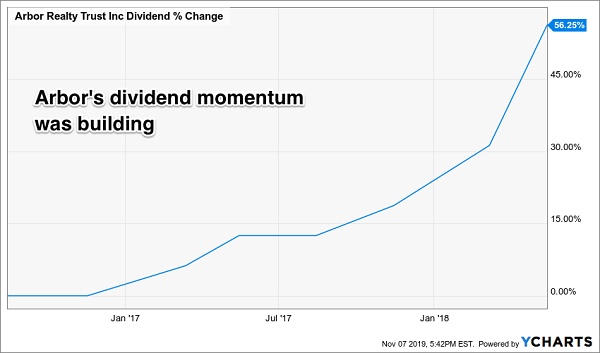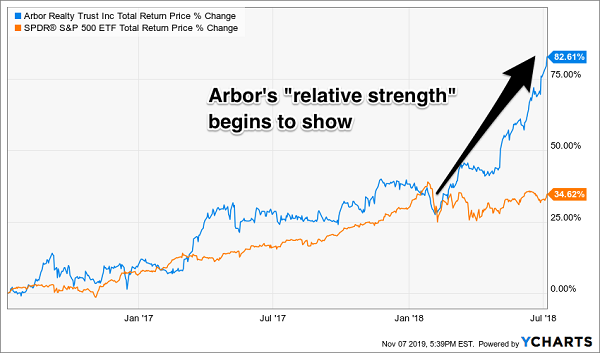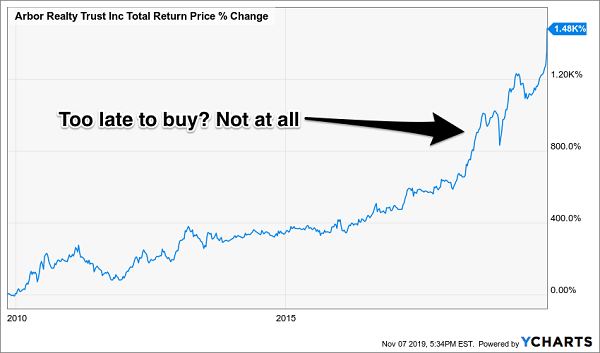This week we’re going to get a bit greedy (responsibly, of course) and discuss fast double-digit gains from safe dividend stocks. Many of you probably sat back and enjoyed Arbor Realty Trust (NYSE:ABR) “parabolic” move to the upside in recent weeks. Since we purchased Arbor for our Contrarian Income Report portfolio in July 2018, we’ve enjoyed epic 60% total returns!
This Tree Might Grow to the Sky

We paid $10.85 per share and have already collected $1.51 in dividends, about 14% of our initial capital—in 16 months!
Payouts alone have provided a solid return, but it’s been the price gains that have really made this stock a winner. Let’s break down what we saw in Arbor a summer ago because these steps (six of them, to be specific) likely hold the secret to our next 60% gain.
Step 1: Find a Safe Dividend
Dividend stocks, as a group, outperform non-dividend payers. Their payout provides them with a “head start” that usually wins the performance race. In Arbor’s case, we bought shares when they yielded 9.6% (quite the head start!) and simply asked management to not lose the race.
Chief Financial Officer (CFO) Paul Elenio explained prior to our purchase:
“We would never have put the dividend at $0.25 (per quarter) if we didn’t feel extremely confident that we’re earning at least that number, if not more.”
And Paul’s financials backed him up. The company had generated $0.28 in AFFO (adjusted funds from operations, Arbor’s measure of actual cash flow) per share in the quarter prior to our purchase. This was a comfortable payout margin for a REIT and meant Arbor’s 9.6% yield on its stock price was secure.
Step 2: Find a Growing Dividend
In the eight quarters prior to our purchase, Paul and his colleagues had hiked Arbor’s dividend six times! The safest dividend is a rising one, and Arbor’s certainly was on the move:
Before: 6 Dividend Hikes in 8 Quarters

Some investors believe they have “bad luck” buying stocks. Everything is humming along until they buy, after which, everything falls apart and their investment tanks.
I believe preparation determines your luck, and when we purchased Arbor, we were ready for success. The dividend momentum continued and we have been rewarded with four more payout hikes. That $1 per share per year dividend that we bought is already $1.20!
Step 3: Buy a Dividend Magnet
Arbor historically yields between 7% and 9%. We were able to buy shares at the high end of this range because the stock’s price had, for whatever reason, fallen behind its dividend.
We reasoned that the rising dividend should act as a “magnet” and, sooner or later, pull the price higher. And that is exactly what’s happened.
A Good Time to Buy: As the Magnet “Kicks In”

Remember, we have already “cashed out” 14% of our initial investment in Arbor thanks to the dividends we’ve received. That’s very good. But for a great return, we need big price gains too. And the safest, surest way to do this is by finding a “dividend magnet.”
Step 4: Lean Towards Good “Relative Strength”
The stock market is exactly that—a market of stocks. Over any given timeframe, some stocks trade with the market, more or less, while some do worse and some do better.
Generally speaking, we want to focus on those that are doing better. The technical term for this is “relative strength,” which simply means that a stock is trading strongly with respect to the broader market. We like this because strong stocks tend to stay strong.
If we rewind to July 2016, two years before our purchase, we see that Arbor traded in-line with the S&P 500. Then, in February 2018, the stock suddenly took off. This was our tipoff that the stock was ready to run. After an extended arm-wrestling battle with the market, Arbor really began to flex its dividend-powered muscles:
This Was Just the Beginning for Arbor

Step 5: Buy New Highs
Stocks that hit new multi-year highs often make even higher highs in the months and years ahead. This is often a tough lesson for contrarian-minded investors to learn, as we independent thinkers would prefer to sort through the discarded bargain bin for hidden gems.
Arbor had been sizzling for a decade when we rolled into its dividend party. Did it care that we were late? Not one bit.
Don’t Be Afraid of New Highs

Most investors hesitate to buy a stock when its price looks “high.” But these levels are relative, and Arbor’s business performance actually warranted an even higher price. We focused on where the business was going, not where the stock had been.
This, by the way, is the part of momentum investing that works. Stock prices are often “too slow” in moving from point A to point B, especially when new highs are involved. Investors hesitate to pay more and more. In this case, their hesitation gave us the opportunity to roll into the festivities late and still bank 63% profits.
Step 6: Let the Winner Run
I’ve been hearing from subscribers who have wanted to book gains in Arbor since we bought it. After all, the stock started moving higher from the moment we bought it, and some folks believe that “you’ll never go broke taking a profit.”
While true, you’ll never get rich taking a profit too soon either. Since we bought shares, they have been in a nice uptrend, paying us a generous (and increasing!) dividend every quarter. The lone pullback was a buying opportunity. Why sell?
Sure, a fast 6.3% gain is nice, but I’ll take the 63% total return. At this rate, we’re doubling our money in less than two years. Mr. and Ms. Market don’t always gift us with well-priced money machines like Arbor. But when they do, we shouldn’t be so quick to return the cash cow!
“Brett, What’s the Best Way to Increase Wealth Long-Term?”
Several subscribers have written in recently asking which dividend strategy is the best one to increase their wealth over the long haul. That’s easy. It’s Hidden Yields and its 17%+ yearly returns.
At this rate, we’re doubling our money every four years. We’re doing it simply by buying the stocks that are increasing their dividends the fastest. And we’re buying without worrying about the bear market boogeyman that unravels most investors.
Remember, for us, bear markets are buying opportunities. December’s plummet sure was! Our secret was that we didn’t panic. We held onto our elite dividend growers and used the opportunity to buy more.
Many investors want to turn back the clock buy Arbor when it was cheaper. Of course, they can’t, but you can do the next best thing and buy my seven favorite dividend growers right now.
Don’t regret not buying these seven when we revisit these picks months from now! All are poised for fast 63% gains, too.
7 Dividend Stocks Ready to Return a Fast 63%
I use computers, screens, tools and my own head to uncover dividend moonshots that will easily pay you 17% per year. That’s enough to double your money in just over 4 years.
Imagine, turning a retirement ‘pot’ of $250,000 into $500,000… or… $500,000 into $1,000,000… and on it goes.
Disclosure: Brett Owens and Michael Foster are contrarian income investors who look for undervalued stocks/funds across the U.S. markets. Click here to learn how to profit from their strategies in the latest report, "7 Great Dividend Growth Stocks for a Secure Retirement."
